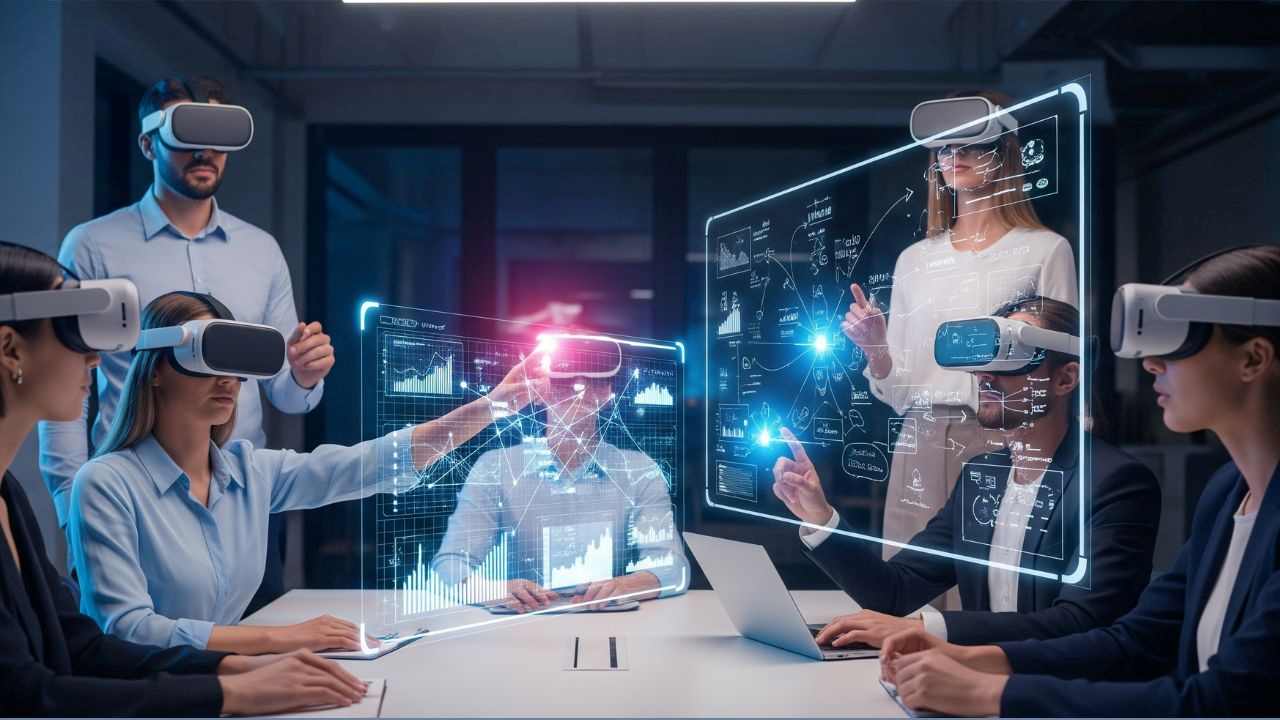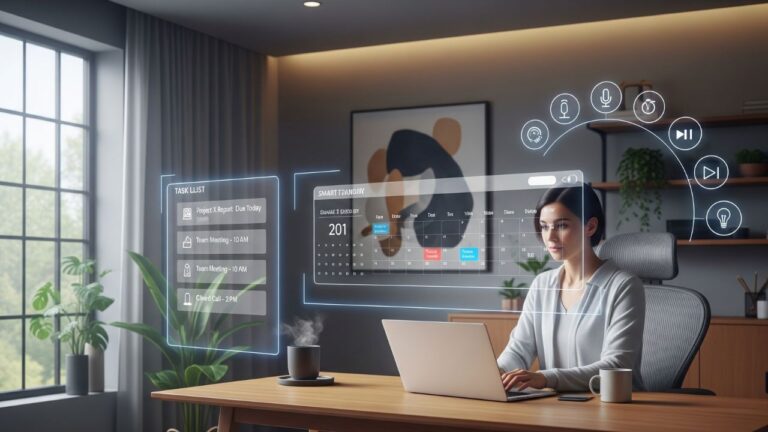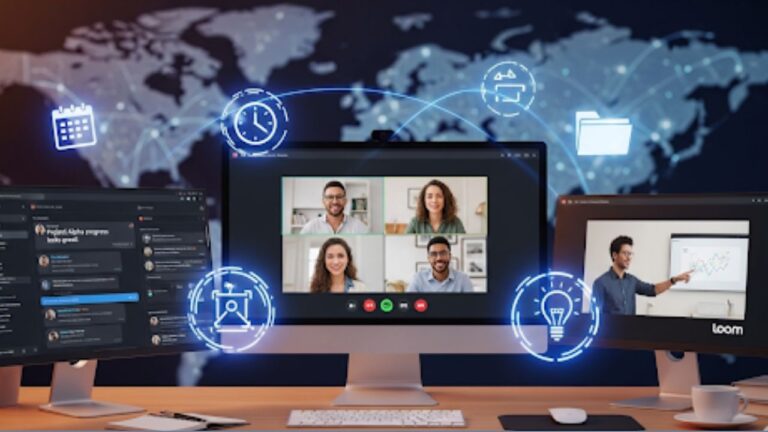Virtual Collaboration Through AR/VR: A Must-Watch Trend for Remote Meetings in 2025
As remote work solidifies its place in the global workforce, augmented reality (AR) and virtual reality (VR)—collectively known as extended reality (XR)—are transforming virtual collaboration in 2025. With 62% of interviews conducted virtually and 30% of tasks projected to be automated by 2030, per a 2024 McKinsey report, AR/VR technologies are revolutionizing remote meetings by creating immersive, interactive environments. From healthcare to tech, these tools enhance engagement, streamline workflows, and bridge geographical divides. This blog explores why AR/VR is a must-watch trend for remote meetings, key examples, benefits, and challenges, with a focus on its growing impact across industries.
The Rise of AR/VR in Remote Collaboration
AR/VR technologies create immersive digital spaces where users interact via avatars, holographic displays, or augmented overlays. In 2025, the global XR market is projected to reach $125 billion, growing at a 36.5% CAGR, per IndexBox. This surge is driven by advancements in lightweight headsets (e.g., Apple Vision Pro, Meta Quest 4), 5G connectivity, and AI integration, making AR/VR accessible for enterprise use. Remote meetings, once limited to 2D video calls, now leverage XR to simulate in-person collaboration, addressing the 35% of remote workers reporting “Zoom fatigue” in a 2024 Forbes survey.
Key Examples of AR/VR in Remote Meetings
1. Virtual Meeting Spaces
- Functionality: Platforms like Meta’s Horizon Workrooms and Microsoft Mesh create 3D virtual conference rooms where participants interact via avatars. AI-driven features, such as real-time translation and gesture recognition, enhance communication.
- Real-World Impact: A 2025 Gartner report noted that 40% of Fortune 500 companies adopted VR meeting spaces, reducing travel costs by 20% and improving team engagement.
- Use Case: Global tech firms use VR rooms to brainstorm product designs, with 3D models manipulated in real time, boosting creativity by 25%, per a Harvard Business Review study.
2. AR-Enhanced Collaboration
- Functionality: AR overlays digital information onto the physical world via smart glasses or mobile devices. Tools like Spatial or HoloLens 2 enable remote teams to share holographic prototypes or annotate real-world objects.
- Real-World Impact: In healthcare, AR platforms like AccuVein’s vein visualization system, integrated with Microsoft Teams, allow remote specialists to guide procedures, reducing errors by 15% in 2024 trials.
- Use Case: Engineers collaborate on machinery repairs by overlaying schematics, cutting downtime by 30%, per a 2025 IEEE study.
3. Hybrid Training and Simulations
- Functionality: VR simulations provide immersive training for remote teams. In healthcare, platforms like Osso VR train surgeons on complex procedures, while tech firms use VR for cybersecurity drills.
- Real-World Impact: A 2025 HealthTech Magazine report found that VR training reduced onboarding time for rural hospital staff by 25%, addressing staffing shortages amid budget cuts.
- Use Case: Cybersecurity teams use VR to simulate phishing attacks, improving response rates by 20%, per Microsoft’s 2024 Cybersecurity for Rural Hospitals Program.
4. Immersive Brainstorming and Design
- Functionality: AR/VR tools like Gravity Sketch enable teams to co-create 3D designs in virtual spaces, integrating with AI tools like GPT-5 for real-time feedback.
- Real-World Impact: A 2025 TechCrunch case study highlighted a 35% increase in design iteration speed for automotive companies using VR collaboration.
- Use Case: Marketing teams visualize campaigns in virtual environments, enhancing pitch success rates by 18%, per a Forbes report.
Benefits of AR/VR for Remote Meetings
1. Enhanced Engagement and Presence
- AR/VR creates a sense of “being there,” combating disengagement in remote settings. A 2025 Stanford study found that VR meetings increased participant focus by 30% compared to video calls.
- Avatars and spatial audio mimic in-person dynamics, fostering stronger team cohesion.
2. Improved Collaboration and Creativity
- 3D visualization and real-time manipulation of digital assets enhance brainstorming. A 2024 MIT Technology Review analysis reported a 22% boost in innovation for teams using AR/VR.
- Cross-functional teams, like those in healthcare, collaborate seamlessly on complex tasks, such as surgical planning.
3. Cost and Time Savings
- AR/VR reduces travel needs, saving enterprises $1.2 million annually on average, per a 2025 Deloitte report. This is critical for rural healthcare facilities facing $70 billion in Medicaid cuts over 10 years.
- Faster decision-making and prototyping accelerate project timelines.
4. Scalable Training and Accessibility
- VR training scales across geographies, vital for industries like healthcare with dispersed workforces. A 2025 HIMSS report noted a 20% reduction in training costs for hospitals using VR.
- AR glasses improve accessibility for remote workers with disabilities, supporting inclusive collaboration.
Challenges to Adoption
Despite its potential, AR/VR faces barriers:
- Cost and Infrastructure: High-quality headsets ($500–$3,500) and 5G dependency strain budgets, particularly for rural hospitals, per a 2025 HealthTech Magazine report.
- Learning Curve: Staff require training to use AR/VR effectively, with 40% of users reporting initial discomfort, per a 2024 Forbes survey.
- Cybersecurity Risks: Immersive platforms increase attack surfaces, necessitating next-generation firewalls and user training, as seen in Microsoft’s 2024 rural hospital program.
- Health Concerns: Prolonged VR use can cause motion sickness, affecting 15% of users, per a 2025 Journal of Human-Computer Interaction study.
Strategies for Successful Implementation
To leverage AR/VR for remote meetings, organizations should:
- Start with Pilots: Test AR/VR in small teams to demonstrate ROI, as done by 30% of tech firms in 2024, per Gartner.
- Invest in Training: Use short, role-specific modules to upskill staff, mirroring Microsoft’s success in training 1,000 rural hospital staff.
- Enhance Security: Integrate AR/VR platforms with secure cloud solutions, like NTT DATA’s Microsoft Cloud unit, to protect data.
- Choose Scalable Solutions: Opt for platforms like Microsoft Mesh or Spatial, which support hybrid environments and integrate with existing tools like Teams.
The Future of AR/VR Collaboration
By 2030, AR/VR is expected to dominate remote collaboration, with the XR market projected to reach $450 billion, per IndexBox. Advancements in lightweight headsets, haptic feedback, and AI integration (e.g., GPT-5-driven avatars) will create hyper-realistic meeting spaces. In healthcare, AR/VR could enable real-time surgical collaboration across continents, while tech firms may use VR for global hackathons. Rural hospitals, facing budget constraints, can leverage cloud-based AR/VR solutions to access expertise remotely, ensuring equitable care delivery.
Conclusion
AR/VR is a must-watch trend for remote meetings in 2025, offering immersive, efficient, and engaging collaboration. From virtual meeting spaces to AR-enhanced training, these technologies are transforming how teams connect, particularly in healthcare and tech. While challenges like cost and cybersecurity persist, strategic implementation and partnerships with providers like NTT DATA or Microsoft can unlock AR/VR’s full potential. As remote work evolves, embracing AR/VR will be critical for organizations aiming to stay competitive, collaborative, and innovative in a rapidly changing world.



